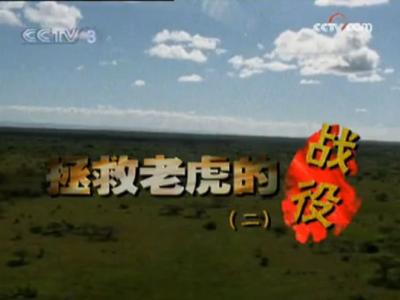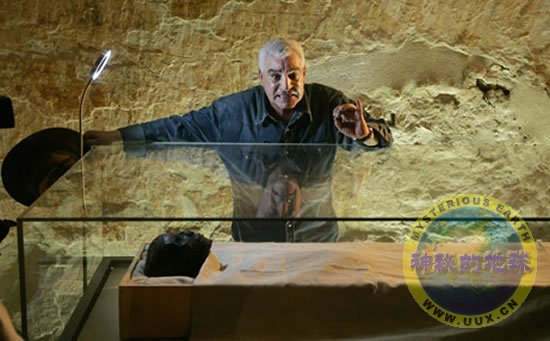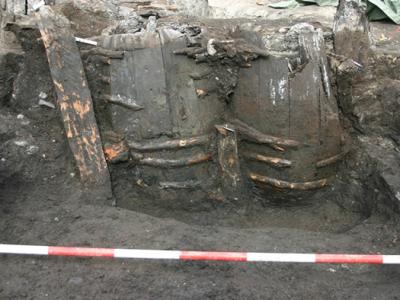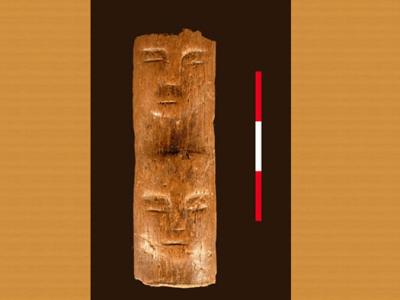Tut Move Designed to Save Mummy

Egyptian antiquities chief Zahi Hawass shows off the linen-wrapped mummy of King Tut in his new high-tech display case.
The body was moved on November 4, 2007, from an inner sarcophagus to the antechamber of Tut's tomb, located in the famed Valley of the Kings near Luxor, Egypt. While generating tourist revenue is one reason for the move, experts say the new case will also serve to protect a mummy so damaged by heat and humidity that it could otherwise have crumbled to dust in a few decades.
Steven Stanek in Luxor, Egypt
for National Geographic News
November 4, 2007
The mummy of the famed boy pharaoh Tutankhamun went on public display for the first time today, when he was moved from his sarcophagus to a high-tech glass case in the antechamber of his tomb near Luxor. (Read the full story on the move and Tut's enduring mystique.)
The transfer is expected to draw thousands of visitors fascinated by the 3,000-year-old body—which fewer than a hundred people have ever seen in person until now—generating needed funds for the preservation of Egyptian antiquities.
(See video and photos of the transfer.)
But experts said the move serves an equally important purpose: preserving the remains, which have deteriorated rapidly from heat and humidity since the opening of Tut's tomb 85 years ago today.
The damage is so bad that if the mummy had remained in its original location, it may have disintegrated within decades.
"The mummy is in danger and needs some immediate protection," said Zahi Hawass, secretary general of Egypt's Supreme Council of Antiquities.
Hawass led a team that examined the mummy in 2005 using a CT scanner—the first time the mummy was removed from its tomb in the Valley of the Kings in almost 80 years.
At that time the archaeologist noticed a significant decline in Tut's condition.
"In less than 50 years the mummy could [have been] completely deteriorated" if it had been left in its sarcophagus, said Hawass, who is also an explorer-in-residence with the National Geographic Society, which owns National Geographic News.
The body's new resting place is one of the most advanced display cases in the world. It can precisely control humidity and airflow, and it will be filled with a nitrogen-rich mixture deadly to known bacteria and mold.
Similar cases are used to preserve one of the four existing copies of the Magna Carta, an original copy of the U.S. Declaration of Independence, and the family bible of former U.S. president Abraham Lincoln.
Mummy in Danger
When British archaeologist Howard Carter and his team unwrapped Tutankhamun's mummy in 1925, they found the body intertwined with jewels and amulets, all embedded in the hardened embalming resin used during mummification.
To remove Tut from the coffin and free the gems, Carter's team dismembered the mummy, cutting it in half at the pelvis and dividing it into 18 separate pieces.
The team also disconnected Tut's head from his torso to remove the king's iconic gold funerary mask.
Since then the mummy has rapidly deteriorated, particularly from elevated humidity and heat generated by the breathing of the 350 daily visitors to the tomb's antechamber.
The relative humidity had reached 95 percent, said Shin Maekawa, senior scientist at the Los Angeles, California-based Getty Conservation Institute. Maekawa measured the tomb's interior climate a decade ago.
"It is almost a saturated condition … and in that condition any organic object will be attacked by fungi and mold," he said.
"The tomb doesn't have any ventilation or any system to refresh the air, so the density of carbon dioxide and moisture generated by visitors tend to remain in the tomb."
Mummies can survive for thousands of years, in part because tombs were closed with an airtight seal in ancient times.
Once the tomb was opened, Maekawa pointed out, outside air was allowed in and the conditions "became very unstable."
According to Kent Weeks, an Egyptologist who discovered nearby tombs belonging to the pharaoh Ramses II's sons, the climate and high visitation rates have already taken their toll.
"So much of it has already been damaged," he said. "They are probably dealing with about only 70 percent of what originally was there"
High-Tech Home
The mummy's new home is designed to keep the remains from suffering any further damage.
The showcase is built on a steel base, with a rectangular glass case 6.5 feet (2 meters) long and 3.3 feet (a meter) wide. The glass hood opens as one piece with four electro-hydraulic lifters.
A filtration system allows a maximum of 10 percent of the case's display volume to be exchanged with the outside air every 24 hours, according to Allan Dallas, sales director of Glasbau Hahn, the German company that built it.
That is about as airtight as glass cases can be without caving in, he said.
According to Dallas, the case will eventually be fed by a generator to create an environment of 99.6 percent nitrogen within its confines, killing all microorganisms. Normal atmospheric air is roughly 80 percent nitrogen.
"If you have a mummy—an organic object—and you have 99.6 percent of nitrogen in the case, nothing can survive," he said. "Any environment over 99.5 will kill all living things."
The display case currently has no temperature controls, and it's unclear whether Egyptian officials plan to purchase such a system or simply let the body rest under current conditions.
Delicate Transfer
This morning the mummy lay behind a thick sheet of glass inside the burial chamber—a damp, musty place about 65 feet (20 meters) below ground with palpably thick air. Despite the glass covering, dust had entered the sarcophagus and had settled over the ancient body.
For the transfer, the mummy was not touched at all. Four to five men took off the dusty sheet of protective glass, opened the sarcophagus, and put the top of the sarcophagus on the floor. They then slung two ropes under the wooden box, pulled it up and out, and walked it over to the new display case about 30 feet (9 meters) away.
The mummy and the box are estimated to weigh 40 to 50 pounds (18 to 23 kilograms), according to Mostafa Wazery, an Egyptologist with the antiquities council.
The process was choreographed the day before, Wazery said, so the chances for major harm were extremely small.
But the mummy could have suffered some minor damage during the transition, said Salima Ikram, a professor of Egyptology at the American University of Cairo.
"Whenever you touch an ancient object and move it from one place to the other—no matter what the object, unless it's a solid granite block—there will be some disturbance of its equilibrium," she said.
"Basically since 1922 he's been in this coffin and sarcophagus, with a cover to it, so that's been a microclimate that is going to be very different than the one he is going to be entering into now."












